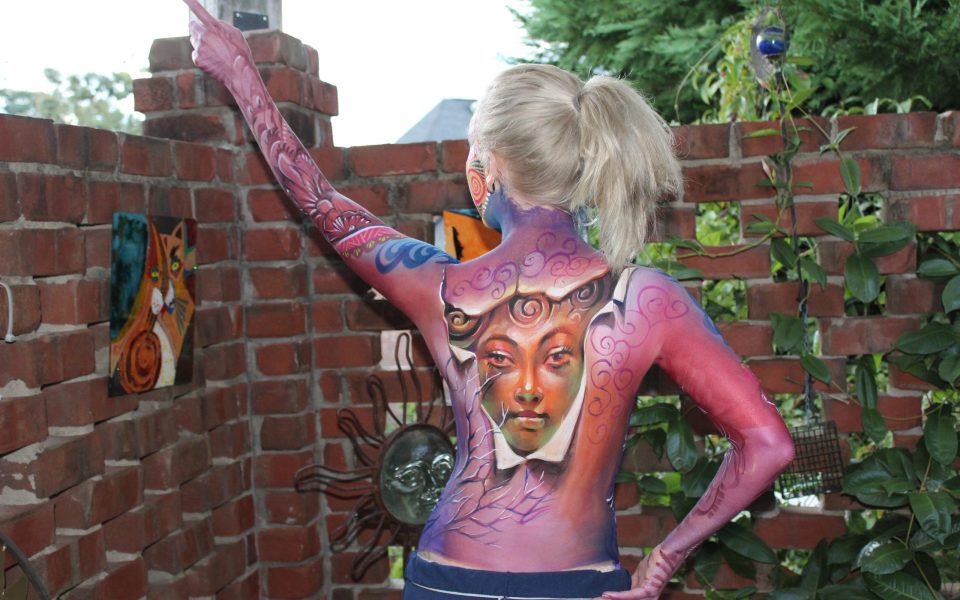Model Taylor Ridge stood quietly in the middle of the kitchen floor offering up her barely clad body as living canvas to four artists who danced their own personal waltz around her, while somehow managing not to step on one another’s toes.
“Many people have objections because it is a body,” painter Panchali Banerjee said. “You can paint sculptures or paint on walls. Why do you want to paint on a body?”
Beth Barr and her husband, fellow painter Frank Orthel, have opened their home to five-time world bodypainting champions Scott Fray and Madelyn Greco and current world bodypainting champions Sanatan Dinda and Panchali Banerjee, here from India, to demonstrate their process and art.
This is Dinda and Banerjee’s first trip to the United States, and they are beyond excited to be in North Carolina. That’s because Wednesday marks the beginning of the Living Art America North America Bodypainting Championship in Greensboro, produced by Fray and Greco.
“That’s Madelyn Greco, she is half of the five-time world bodypainting champions,” said Orthel. “That’s never happened before and will probably never happen again.”
Greco took a moment to shoot a smile across the room but didn’t stop coating model Taylor Ridge’s torso in a blanket of white paint.
“This couple competed last year and placed second,” said Orthel. “And then this year they won so now they are world champions.”
Banerjee leaned against the counter watching Greco add gold lining along Ridge’s ribcage while Dinda simultaneously worked on a face breaking through the skin of the model’s back. Orthel had become fixated on blending blues and purples into Ridge’s skin. The temperature of the space felt warmer by the minute as their pace steadied, however, on the model chill bumps started to make their appearance from underneath the body paint.
“It’s not about the nudity,” Banerjee said. “No one is worried about the nudity. The main thing is why are we painting on a body. That is the main question. I think that that is the challenge for us. For me, if you are painting on a canvas or sculpture it doesn’t react. This is a moving surface. She has her own identity and she can react.”
Every so often one of the artists asked a question or two of Ridge like whether she was holding up okay, if she needed a snack break, or if it’s okay to paint her underwear an intense shade of purple.
“I bought a bunch of pairs because they were on sale,” Ridge said.
“Thattagirl,” Greco replied.
The session was going as smooth as if it was a regular occurring Monday night gathering. Tarp on the floor. The house cat checked the progress of the humans every so often. Paintbrush pouches strewn across counter tops amidst sponges, travel cases, refreshments and a numerous amount of bodypaint compacts. And an epic ’70s mix playing on the radio. But not every session goes as effortlessly.
“We had a practice model once who got food poisoning from fast food or something on the way to us,” Greco said. “And she commences to have food poisoning while we were painting her. She was faint and just had a rough day, however, she didn’t quit.”
The paints that cloaked Ridge’s skin had slowly fused with the more permanent art inked on her flesh. A tree tattoo, doubled in size with bodypaint, appears to be missing its leaves due to a cold winter. Her torso had grown blue wings with white accents and lace filigree. And the tape that covered her breasts was now lost amongst fire-engine reds and burnt oranges.
“What we are doing, instead of creating art that is an illusion on a flat surface,” Fray said, “we are creating art on the form itself. It’s the only form of art that that can look back at you as you look back [at] it. It is the only form of art that has a soul.”
Ridge mentioned that she generally embodies a character when she is in full make-up. Although this was more of a quick practice session, taking two hours to complete versus some sessions that can take up to a whole day, a fluidity could be seen in the model’s movements that is more in synch with the art that incased her body.
“Nobody was doing this here,” Greco said. “There are face-painter conventions and there’s some different things here and there but nobody was really doing anything close to what the World Bodypainting Festival was doing. There was nothing for American artists who wanted to get their feet wet or to get international artist the impetus to come to America. So we thought somebody has got to do it and we did it”
Fray credits the move of the competition from Atlanta to Greensboro to the “goodwill and faith of the Arts Council of Greensboro and a few select people that had the vision and willingness to take a chance on something that may have been out of the box but felt that it was a beautiful, expressive and viable art form.”
“You guys near done?” asked Orthel.
“I’m ready to send her off,” Fray said.
Fray walked away from his subject, ending his participation. Until something caught his eye. He then headed toward Ridge’s face with his brush in tow.
“Okay,” Fray said.
He picked up a case of blue paint and fixed a blue line on the letter A on her chest.
“I’m done.”
Join the First Amendment Society, a membership that goes directly to funding TCB‘s newsroom.
We believe that reporting can save the world.
The TCB First Amendment Society recognizes the vital role of a free, unfettered press with a bundling of local experiences designed to build community, and unique engagements with our newsroom that will help you understand, and shape, local journalism’s critical role in uplifting the people in our cities.
All revenue goes directly into the newsroom as reporters’ salaries and freelance commissions.





Leave a Reply